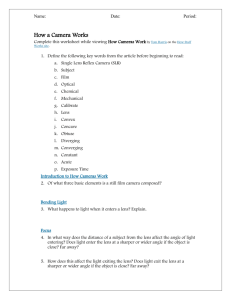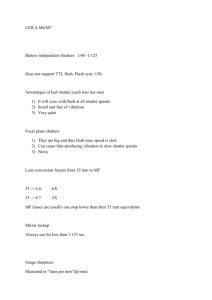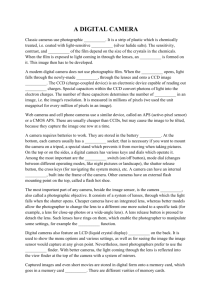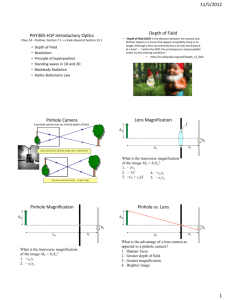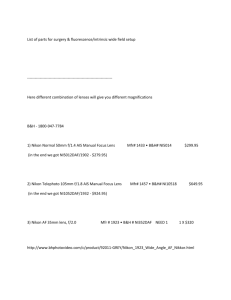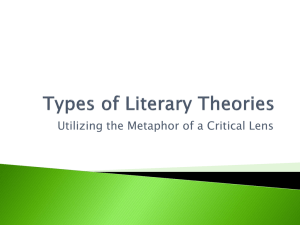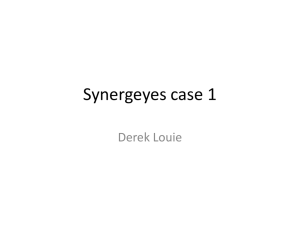lecture23
advertisement
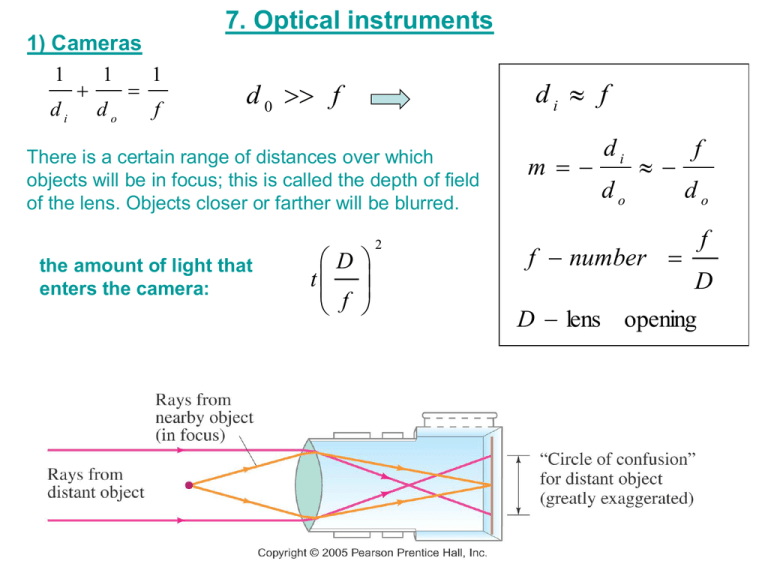
7. Optical instruments 1) Cameras 1 1 1 di do f di f d 0 f There is a certain range of distances over which objects will be in focus; this is called the depth of field of the lens. Objects closer or farther will be blurred. the amount of light that enters the camera: D t f 2 m di do f do f f number D D lens opening 1a) Basic parts of a camera. Camera adjustments. •Focusing: this adjusts the position of the lens so that the image is positioned on the film. •Shutter speed: controls the amount of time light enters the camera. •f-stop: controls the maximum opening of the shutter. This allows the right amount of light to enter to properly expose the film, and must be adjusted for external light conditions. A digital camera uses CCD sensors instead of film. The digitized image is sent to a processor for storage and later retrieval. Example: Suppose that a correct exposure is 1/250 s at f/11. Under the same conditions, what exposure time would be needed for a pinhole camera if the pinhole diameter is 1.0 mm and the film is 7.0 cm from the hole? The pinhole camera uses a tiny pinhole instead of a lens. t 1 / 250 s 2 2 D D' t ' t t ' f f ' D f/ 11 D' 1.0 mm f ' D ' t f D 2 2 70 mm / 1mm t ' 1 / 250 s 0 . 16 s 11 f ' 7 . 0 cm t ' ? Example: What is the focal length of the eye-lens system when viewing an object (a) at infinity, and (b) 33cm from the eye? Assume that the lens-retina distance is 2.0cm. d i 2 cm 1 a )d 0 do b ) d 0 33 cm f ? 1 di 1 f a ) f d i 2 cm b) 1 f 1 33 cm 1 2 cm f 1 . 9 cm 2) The Human Eye The human eye resembles a camera in its basic functioning, with an adjustable lens, the iris, and the retina. Most of the refraction is done at the surface of the cornea; the lens makes small adjustments to focus at different distances. 3) Corrective Lenses a) Nearsightedness can be corrected with a diverging lens. b) And farsightedness with a diverging lens. Near point: closest distance at which eye can focus clearly. Normal is about 25 cm. Far point: farthest distance at which object can be seen clearly. Normal is at infinity. Nearsightedness: far point is too close. Farsightedness: near point is too far away. Vision is blurry underwater because light rays are bent much less than they would be if entering the eye from air. This can be avoided by wearing goggles. Example: A person cannot see clearly objects more than 70.0 cm away. What power of lens should be prescribed if the glass is to be worn 1.00 cm in front of the eye? d 70 . 0 cm fp d g 1 . 00 cm P? d i f d fp d g P 1/ f P 1 / d fp d g 1 / 0 . 69 m 1 . 45 D Example: A nearsighted person wears glasses whose lenses have power of -0.15D. What is the person's far point if the glasses are very close to the eyes? P 0 . 15 D d ge 0 f ? di 0 f 1 P 1 0 . 15 dg m 6 .7 m f 6 .7 m dg d p do dg d p di d g Example: What power lens is needed to correct for farsightedness where the uncorrected near point is 75 cm? d o 25 cm 1 d i 75 cm di P? P 1 do 1 1 P f 0 . 75 m 1 0 . 25 m 1 3 2 0 . 75 m 0 . 75 m 8 2 .7 D 3m Example: A farsighted person can read a newspaper held 25 cm from his eyes, if he wears glasses of +3.33 diopters. What is this person's near point? d o 25 cm 1 P 3 . 33 D di di ? 1 di 1 do 1 1 P di f 1 0 . 25 m 10 3m 12 10 3m 1 3 . 33 D 0 . 25 m 2 3m d i 1 .5 m 4) Aberrations of Lenses and Mirrors a) Spherical aberration: rays far from the lens axis do not focus at the focal point Solutions: compound-lens systems; use only central part of lens b) Distortion: caused by variation in magnification with distance from the lens axis. Barrel and pincushion distortion: c) Chromatic aberration: light of different wavelengths has different indices of refraction and focuses at different points Solution: Achromatic doublet, made of lenses of two different materials

